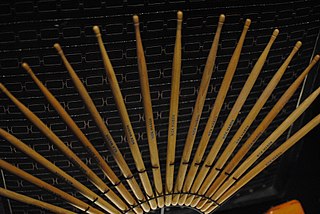Related Research Articles

A cymbal is a common percussion instrument. Often used in pairs, cymbals consist of thin, normally round plates of various alloys. The majority of cymbals are of indefinite pitch, although small disc-shaped cymbals based on ancient designs sound a definite note. Cymbals are used in many ensembles ranging from the orchestra, percussion ensembles, jazz bands, heavy metal bands, and marching groups. Drum kits usually incorporate at least a crash, ride, or crash/ride, and a pair of hi-hat cymbals. A player of cymbals is known as a cymbalist.

A drum kit is a collection of drums, cymbals, and sometimes other auxiliary percussion instruments set up to be played by one person. The drummer typically holds a pair of matching drumsticks, and uses their feet to operate hi-hat and bass drum pedals.
A crash cymbal is a type of cymbal that produces a loud, sharp "crash" and is used mainly for occasional accents, as opposed to a ride cymbal. It can be mounted on a stand and played with a drum stick, or by hand in pairs. One or two crash cymbals are a standard part of a drum kit. Suspended crash cymbals are also used in bands and orchestras, either played with a drumstick or rolled with a pair of mallets to produce a slower, swelling crash. Sometimes a drummer may hit two different crash cymbals in a kit at the same time to produce a very loud accent, usually in rock music.
The ride cymbal is a cymbal of material sustain used to maintain a beat in music. A standard in most drum kits, the ride's function is to maintain a steady pattern, sometimes called a ride pattern, rather than provide the accent of a crash cymbal. It is normally placed on the extreme right of a drum set, above the floor tom. It is often described as delivering a "shimmering" sound when struck soundly with a drumstick, and a clear ping when struck atop its bell.
Cymbals are made from four main alloys, all of them copper-based. These are: bell bronze, malleable bronze, brass, and nickel silver.
Modern cymbal making comprises many different techniques, from traditional hand methods to completely automated mass-production.

A sizzle cymbal is a cymbal to which rivets, chains or other rattles have been added to modify the sound, attached either by means of holes bored in the cymbal or by means of an attachment known as a sizzler.

Clash cymbals are cymbals played in matched pairs by holding one cymbal in each hand and striking the two together.

In western music, a China cymbal is a distinct type of crash cymbal designed to produce a bright, crisp, and explosive tone that has brought it the nickname trash cymbal. The name "China cymbal" comes from its shape, which is similar to that of the Chinese Bo. Such cymbals are most frequently mounted upside down on cymbal stands, allowing for them to be more easily struck and for a better sound.

Zills or zils, also called finger cymbals, are small metallic cymbals used in belly dancing and similar performances. They are called sāgāt in Egypt. They are similar to Tibetan tingsha bells. In Western music, several pairs can be set in a frame to make a tambourine.
In a drum kit, splash cymbals are the smallest accent cymbals. Splash cymbals and china cymbals are the main types of effects cymbals.

The swish cymbal and the pang cymbal are exotic ride cymbals originally developed and named as part of the collaboration between Gene Krupa and the Avedis Zildjian Company. The current Zildjian Swish Knocker is a redesign of their original swish, with more rivets, deeper bow and shallower bell, based on a cymbal made famous by Mel Lewis, who coined the name knocker.

Marching percussion instruments are percussion instruments specially designed to be played while moving. This is achieved by attaching the drum(s) to a special harness worn by the drummer, although not all marching bands use such harnesses and instead use traditional baldrics to sling their drums.
In music, a breakdown is a part of a song in which various instruments have solo parts (breaks). This may take the form of all instruments playing the verse together, and then several or all instruments individually repeating the verse as solo parts.

A bell cymbal, bell splash cymbal, or ice bell is a small, very thick cymbal with little if any taper, used as an effects cymbal in a drum kit. The sound produced when striking the bell cymbal with a drumstick is a distinctive high-pitched ping sound with a long sustain. Some manufacturers list bell cymbals as a type of splash cymbal, others as a distinct type.

A drum stick is a type of percussion mallet used particularly for playing snare drum, drum kit, and some other percussion instruments, and particularly for playing unpitched percussion.

A crash/ride cymbal is a medium weight, slightly tapered cymbal, normally in the 18–22-inch (460–560 mm) range, designed to serve in a drum kit as both a crash and a ride cymbal.

Heavy metal drumming is a style of rock music drum kit playing that developed in the late 1960s and early 1970s, largely in the United States and the United Kingdom. With roots in blues rock and psychedelic/acid rock drum playing, heavy metal drummers play with emphatic beats, and overall loudness using an aggressive performing style. Heavy metal drumming is traditionally characterized by emphatic rhythms and dense bass guitar-and-drum sound.
Hammerax is an American percussion and cymbal manufacturer, launched in 2006 headed by Audio engineer John Stannard. Hammerax is known for their unique percussive creations and unusual instrument designs, which have received mixed reviews from customers.
References
- ↑ Strain, James Allen (2017). A Dictionary for the Modern Percussionist and Drummer. Rowman & Littlefield Publishers. p. 48. ISBN 978-0-8108-8693-3. OCLC 974035735.